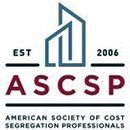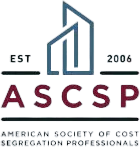About the Exams
Certification & Testing (see samples below)
ASCSP offers two technical membership levels; as such there are two tests available: Member, and Certified Member (CCSP).
All new ASCSP members are Associates until an exam has been taken and passed. Testing applications are now available at both the Member and Certified levels*. Please contact the Testing Committee for more information.
Certified Member (CCSP)
The “CCSP” designation is the highest credential in the cost segregation industry. Specialists with this designation have met ASCSP’s strict level of standards for required work experience and have passed ASCSP exam for Certified members.
Only Certified Members with the CCSP designation can stamp a cost segregation report with the ASCSP seal and use the ASCSP designation in correspondence and credentials.
Requirements for Certified designation include the following:
- Minimum 7 years direct experience performing cost segregation studies.
- Submittal of application package and experience log to document at least 7,000 hours of direct cost segregation experience
- Submittal of sample cost segregation report
- Recommendation of two Certified members
- Telephone interview of applicant (as determined by Testing Committee)
- Obtain passing grade on the Certified exam
Member Level
(move from Associate to full Member) – The Member designation is for individuals with at least 1 year and 1,000 hours of direct technical experience performing cost segregation studies. Requirements for Member designation include the following:
- Minimum 1 year direct experience performing cost segregation studies.
- Submittal of application package and experience log to document at least 1,000 hours of direct cost segregation experience
- Obtain a passing grade on the Member exam
Please see “Membership” page for more information about the different member levels.
*Note: there are small administrative fees to take advancement exams. Some fees can be waived for new members (call for more) , any exam retakes may incur additional fees.
The Examinations (samples)
Both Member and Certified exams will consist of two parts:
Part I
100 question True/False and multiple choice exam covering
- Technical issues
- Legal and tax issues
- Ethics and standards
- ASCSP history, structure and bylaws
- Tangible Property Regulations
Part II
Written exam to demonstrate the applicant’s ability to understand the complex issues associated with scoping of engagements, cost segregation studies, contractual issues, tax and engineering issues, duty of care and relevant issues in the cost segregation industry. The written exam is particularly useful to the graders as the quality of answers demonstrates a greater depth of knowledge than a simple True/False question.
Timing
The applicant is allowed up to four hours per part with a one hour lunch break. Generally most applicants are able to complete the each part of the examination in three hours or less.
Grading
Minimum passing grades for Member are 70% for each part of the exam. Certified level minimum passing grade is 80% for each part of the exam. A retake opportunity for one or both parts of the exam can be arranged after three months from the original date. Contact ASCSP administration with questions.
Exam Locations
While it is strongly encouraged to take the exam at the annual conference, the exam can be proctored by any Certified member anywhere in the United States. Please contact the Testing Committee to discuss individual or group testing at select locations.
Study Material
It is strongly recommended that applicants planning to sit for either exam acquaint themselves with the ASCSP Study Guide which is available for ASCSP members – please send an email to: info@ascsp.org for the download.
While this Study Guide is not the only reference document that should be used in preparation for the examination, a significant effort has been put forward by ASCSP members to include relevant subject matter that will be covered in either exam.
Another important document developed by ASCSP is the Minimum Quality Standards (MQS), which receives periodic updates. Several test questions will be related to this document and it is available at no charge to ASCSP members.
Sample Questions
The following questions are representative of the 100 multiple choice questions that will be included in Part I of the exam:
A computer system used to control the heating, ventilation, and air conditioning system of an office building is classified as:
- A structural component of a building with a 39 year recovery period
- Information Systems with a 5 year recovery period since it is computer equipment
- Office Furniture, Fixtures, and Equipment
- Section 179 property
- None of the above
A project has an electrical panel with 42 circuit breakers, each rated at 20A/1P. Through your detailed analysis you have identified 28 circuit breakers directly associated with assets deemed to be personal property in nature. What percentage of the panelboard, if any, would you classify as personal property?
- The entire panelboard since over 50 percent of the usage of the panel is for personal property assets
- None of the panelboard since the panelboards are always structural components of a building
- 66.7 percent of the panelboard
- 33.3 percent of the panelboard
Bulletin F, otherwise known as IRS Publication Number 173, was issued for what purpose?
- To identify Section 38 property for the Investment Tax Credit
- To provide a useful life guide for various types of property
- To provide standards for cost segregation studies
- To provide standards for tenant finishes and tenant standard allowances in commercial office buildings
- To clarify the allocation of indirect costs in General Contractor payment requests
The project you are working on is a manufacturing facility with an extensive overhead crane system which is supported by the columns and beams which also support the structure. How would you estimate the value of the structural steel directly attributable to the crane system?
- Take 50% of the structural steel costs since it provides a dual use
- Not take any of the steel costs, since structural steel is always a structural component of a building
- Take the weight of the crane as a ratio of the total weight of the steel as the proper percentage
- Do a complete structural analysis of all the structural steel members and use the loads imposed by the crane and its capacity as compared to the building live/dead loads to determine the ratio of KIPS imposed on each structural steel member
- Use an engineering estimating or valuation manual to determine an overall cost per square foot for the steel used by the crane
A one-line diagram can best be described as:
- A graphic representation of the entire plumbing system
- A diagram of the primary electrical components
- A plot plan included in a report showing basic building layouts
- A rendering of the building
- None of the above
Site improvements are generally considered to be 15-year recovery period property. What is the MACRS class for site improvements?
- 00.11
- 00.3
- 57.0
- 00.13
- 26.1
In Whiteco Industries, Inc. v. Commissioner, 65 T.C. 664, 672-673 (1975), the Tax Court established how many questions to ascertain whether a particular asset qualifies as tangible personal property?
- 5 questions
- 6 questions
- 7 questions
- 4 questions
- It did not develop any questions, since the issue in the case was the classification of elevators in a commercial office building
The following questions are representative of the essay portion of the exam.
Question 1:
- You have been assigned to perform a cost segregation study on a used property. Describe in detail the work steps you would perform, the information you would request from the client, and any mitigating circumstances which could affect the results.
Question 2:
- The client (an owner of multiple office buildings) for which you performing a cost segregation study has indicated that, they believe the roof top HVAC units are 7 Year property rather than 39 Year property. The rationale is that the HAVC units are “equipment” and as such are not structural elements of a building. In addition, the client states that the Service has always allowed this classification in previous audits. The client asks you to classify the HVAC units as 7 Year property in the final cost segregation report. Present your rationale either for or against this classification, and how you would present your findings in your final report.
All Rights Reserved | ASCSP
Powered by AutomationLinks
All Rights Reserved | ASCSP | Powered by AutomationLinks

